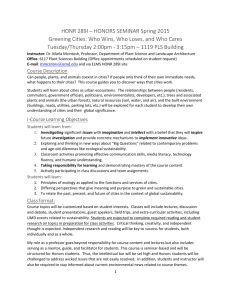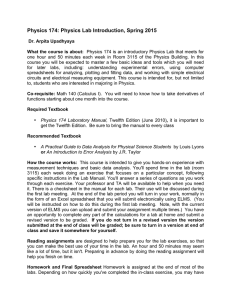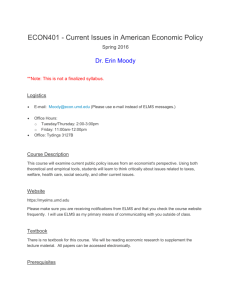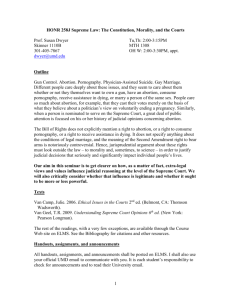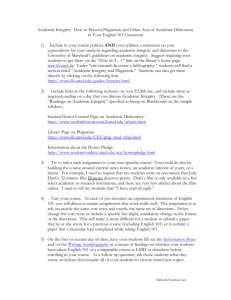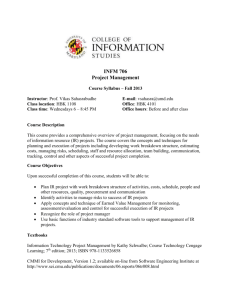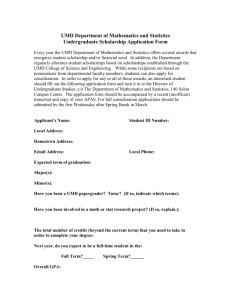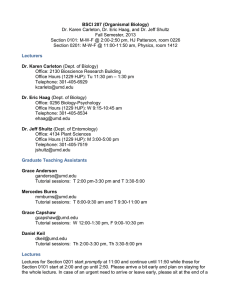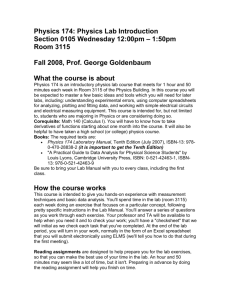Introduction to Online Course Design
advertisement
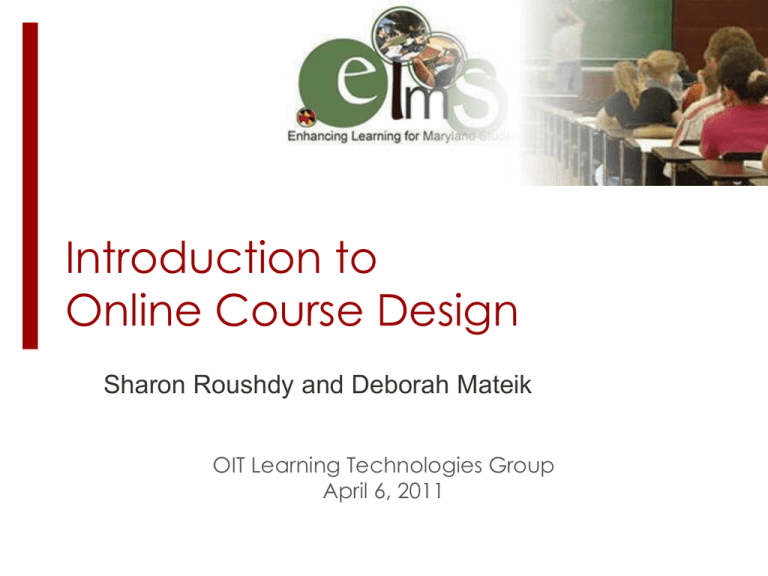
Introduction to Online Course Design Sharon Roushdy and Deborah Mateik OIT Learning Technologies Group April 6, 2011 Main Topics Introduction: Benefits, Challenges, Environments, Resources, Media Selection, and Planning Content Delivery Considerations Communication and Collaboration Assessment and Evaluation Getting Started Benefits of a Well Designed Online Course Flexibility Time Location Improved Interaction Facilitates successful student engagement, learning, and course retention with well designed: student student interaction. student instructor interaction. student content interaction. So, how do we get there? What are the challenges? Guidelines/Checklist See Basic Online Course Components Guidelines (at http://otal.umd.edu/ID-process, under Designing Your Course) More Guidelines Components of Good Online Course Design (http://www.4faculty.org/includes/digdeeper/online/lc_outco mes_based_instruc.htm) A Quality Scorecard for the Administration of Online Education Programs (http://sloanconsortium.org/quality_scoreboard_online_prog ram) Challenges Design (time; iterative process) Identifying outcomes and creating assessments Replacing f2f lecture with appropriate online interactions and activities Adapting and developing materials to the online environment Developing a cohesive and organized online presence and community. Learning to use and feel comfortable with the online tools Teaching Keeping students engaged Keeping students on track Managing workload Planning Your Course Initial standard instructional design questions (the “Ws” that steer you towards “how”) Who are your students? Undergraduates, graduates, working adults, residents, or geographically dispersed, special needs? What are your course goals and objectives? Can objectives be stated in terms of outcomes? When is the term and what is length of your course? Standard term (Fall, Spring) or compressed (Summer, Winter) Online Teaching Environments Live/Synchronous When you need: Increased personal interaction and community Immediacy Spontaneity Online Teaching Environments, cont. Not Live/Asynchronous When you want: To post content/lecture/notes Recorded information and interactions A flexible location and/or time Reflection and response time for students Ongoing discussion Participation tracking Central content distribution Selecting Tools or Media Which tool(s)? Several tools to choose from, some share common features Select the best fit for what you want to accomplish Weigh the advantages and disadvantages and cost/benefits. Not sure? Consult with LT instructional designer Visit otal.umd.edu Take training workshops Experiment Content Delivery How can the content most effectively (or efficiently) be delivered? Synchronously or Asynchronously? Content Delivery Considerations, cont. Online Formats Electronic text Pre-recorded lectures Live online lectures that are recorded Content Delivery Considerations, cont. Materials Development and Organization Length (especially audio, video) Modularity, chunking Consistency Size (smaller is better) Common File formats Text: (e.g., .pdf, .doc/docx, .rtf) PowerPoint (e.g., .ppt/.pptx) Images (e.g., .jpg, .gif, .png) Media: (various) Accessibility ELMS Sample Course UTAP Course (Sample) Example: ECON 200 recorded video) (pre- Wimba Live Classroom Environment Example Screenshot Communication & Collaboration Communication and Interaction between 1 2 3 students and content students and their peers students and instructor Guiding Principles Establishing a community is strategic to the success of an online course The collaborative activities and products are useful tools for promoting community Size of class, level of students (e.g., undergrad vs. grad), course discipline will impact choices made for creating communities and developing activities to foster collaboration and community Communication Tools Available in ELMS Asynchronous (“anytime”) Discussion Board Wikis Blogs E-Mail Wimba Voice Board Synchronous (“same time”) Live Chats Wimba Classroom Wimba Pronto Examples of Collaborative Online Activities Group discussion Guest speakers Case studies Collaborative writing/presentation Debates Panels and studentmoderated discussion Role playing Games Student-led support Demonstrations Peer review Brainstorming Nonverbal communication Assessment and Evaluation Assessment and Evaluation Considerations What will be different when you are fully online? Face-to-face: Proctored, secure No technical issues Must be scheduled, time restriction Online: If un-proctored, less secure (especially for objective tests/quizzes) Possible technical issues Flexible scheduling, although can have time restriction Assessment and Evaluation Considerations Consider more frequent, formative assessments and evaluations: Periodic low-stakes quizzes Pre and post tests Peer assessments (group work) Mid-course evaluation CATs/Formative Assessment/Self-assessments Student reactions and understanding Checkpoint, feedback for instructor Grading strategy: Use rubrics One Minute Paper, Muddiest Point Example questions: What was the most important (useful, significant, crucial) thing you learned in today’s class? In what areas did you understand the most? The least? What was the muddiest point in today’s lecture? Tip: Plan to follow-up with individuals or as a group. Example Tool strategies: ELMS Discussions ELMS Quiz or Survey Examples: KNES 370 and UTAP Release of certain elements of content or assessment tools is made based on student access or completion of other content or assessments. Selective release criteria Summary Good online course design involves: Selecting the most appropriate activities and environments to meet the requirements of your students and course goals and objectives. Consistent and coherent organization of online materials Clear and detailed instructions and expectations Regular instructor communication Instructor feedback on student activities Summary, cont. Planning begins with key considerations regarding: Student characteristics Goals and objectives/outcomes Constraints (e.g., number of weeks, available technologies, etc.) Characteristics of live and asynchrononous environments Content delivery options Communication, collaboration, and interaction possibilities Assessment and evaluation strategies Course management and student support Development of syllabus that incorporates elements of the online environment. Begin: Getting Started Activity Start with a Single Course Module 1. Identify a learning unit or module in your course. 2. Identify a learning outcome associated with this module that supports the course outcomes and goals as a whole. (i.e., I want the students to …..”). 3. What work will students do in this module? (e.g., individual assignment, discussion, group work, quizzes, etc.) 4. Design for online: If have already taught this module f2f, how might you modify or enhance the content delivery, lecture, and student work components using online environment options? If this is a new topic, how might you design it to make the best use of online environments for content, lecture, and student work? Online Tools and Design Resources See the companion ELMS site (login to elms.umd.edu) See http://otal.umd.edu (Your Campus Resource for Online Teaching and Learning) Supported Tools Consultations (Online and Blended Course Design) Training Materials and Resources See Sloan-C workshops (www.training.umd.edu) See Creating an Effective Online Syllabus
